low oil pressure VOLKSWAGEN TRANSPORTER 1992 T4 / 4.G Owners Manual
[x] Cancel search | Manufacturer: VOLKSWAGEN, Model Year: 1992, Model line: TRANSPORTER, Model: VOLKSWAGEN TRANSPORTER 1992 T4 / 4.GPages: 164, PDF Size: 25 MB
Page 5 of 164
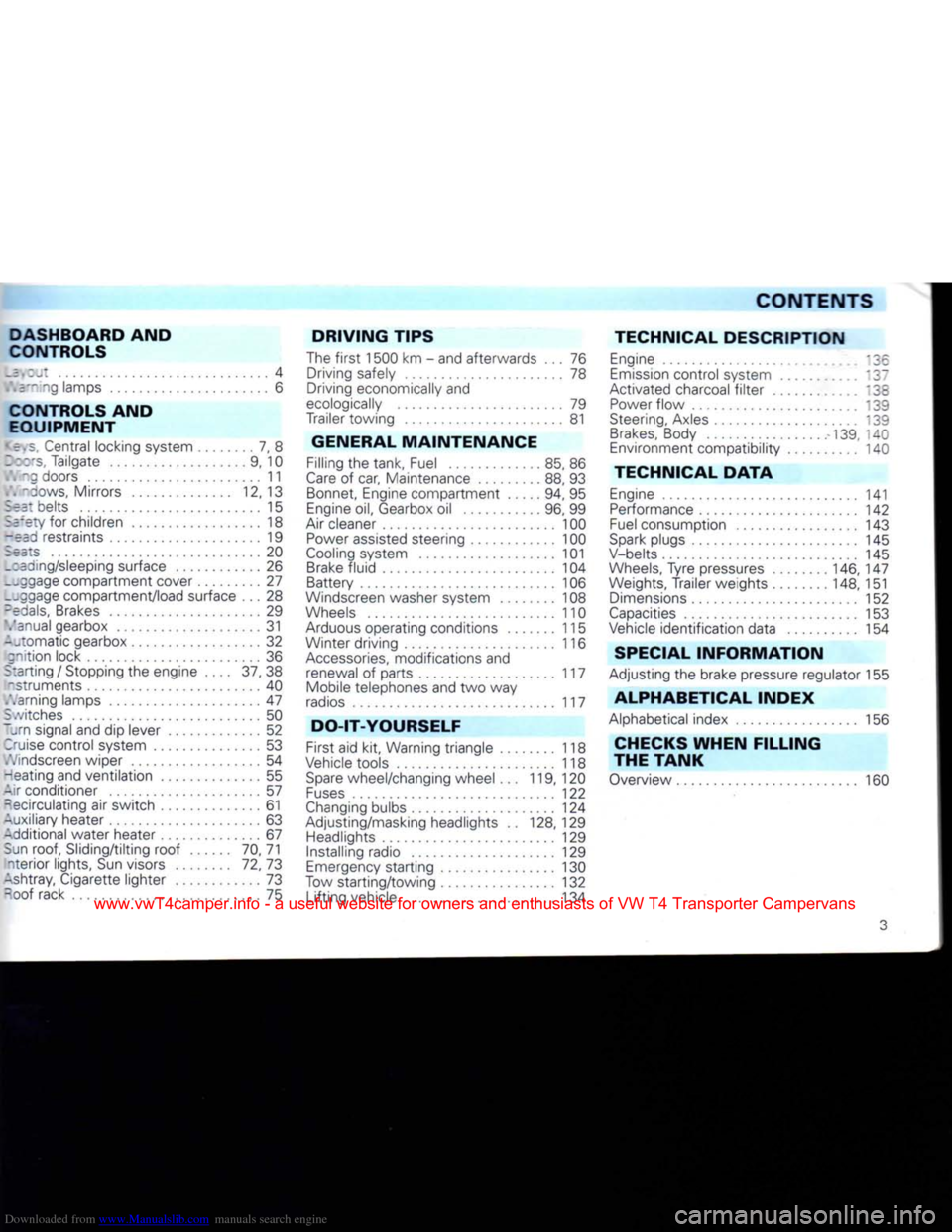
Downloaded from www.Manualslib.com manuals search engine
CONTENTS
DASHBOARD AND
CONTROLS
Layout
4
i\='-:ng
lamps 6
CONTROLS
AND
EQUIPMENT
•
e.s. Central locking system 7, 8
I:cs, Tailgate 9, 10
I'I
~g doors 11
..
-^ows, Mirrors 12, 13
Sea: belts 15 5re:y for children 18
-ead restraints 19
Seats
20 _:ariing/sleeping surface 26
__ggage
compartment cover 27 __cgage compartment/load surface ... 28
-edals, Brakes 29 Vanual gearbox 31
--tomatic gearbox 32
gnition
lock 36
Starting / Stopping the engine .... 37, 38 "struments 40
.'.
arning lamps 47
Switches 50
~yn signal and dip lever 52
3'uise
control system 53 .'.'indscreen wiper 54
-eating and ventilation 55
Air
conditioner 57
Recirculating air switch 61
Auxiliary heater 63
Additional
water heater 67
Sun roof, Sliding/tilting roof 70, 71
nterior lights, Sun visors 72, 73
Ashtray, Cigarette lighter 73
-oof
rack 75
DRIVING
TIPS
The first 1500 km - and afterwards ... 76 Driving safely 78
Driving economically and
ecologically
79
Trailer towing 81
GENERAL
MAINTENANCE
Filling the tank, Fuel 85, 86
Care of car, Maintenance 88, 93 Bonnet, Engine compartment 94, 95
Engine oil, Gearbox oil 96, 99
Air
cleaner 100 Power assisted steering 100
Cooling
system 101
Brake fluid 104
Battery 106
Windscreen washer system 108
Wheels 110
Arduous operating conditions 115
Winter driving 116
Accessories, modifications and
renewal of parts 117
Mobile
telephones and two way
radios 117
DO-IT-YOURSELF
First
aid kit, Warning triangle 118
Vehicle tools 118 Spare wheel/changing wheel ... 119, 120
Fuses
122
Changing
bulbs 124
Adjusting/masking headlights .. 128,129
Headlights 129
Installing radio 129
Emergency starting 130
Tow starting/towing 132
Lifting vehicle 134
TECHNICAL
DESCRIPTION
Engine 136
Emission control system 137
Activated charcoal filter '38 Power flow '39
Steering, Axles 139 Brakes, Body -139,
1
AC
Environment compatibility 140
TECHNICAL
DATA
Engine 141
Performance 142
Fuel consumption 143
Spark plugs 145
V-belts 145
Wheels,
Tyre
pressures 146, 147
Weights,
Trailer weights 148, 151 Dimensions 152
Capacities 153
Vehicle identification data 154
SPECIAL
INFORMATION
Adjusting the brake pressure regulator 155
ALPHABETICAL
INDEX
Alphabetical index 156
CHECKS
WHEN
FILLING
THE TANK
Overview 160
3
www.vwT4camper.info - a useful website for owners and enthusiasts of VW T4 Transporter Campervans
Page 8 of 164
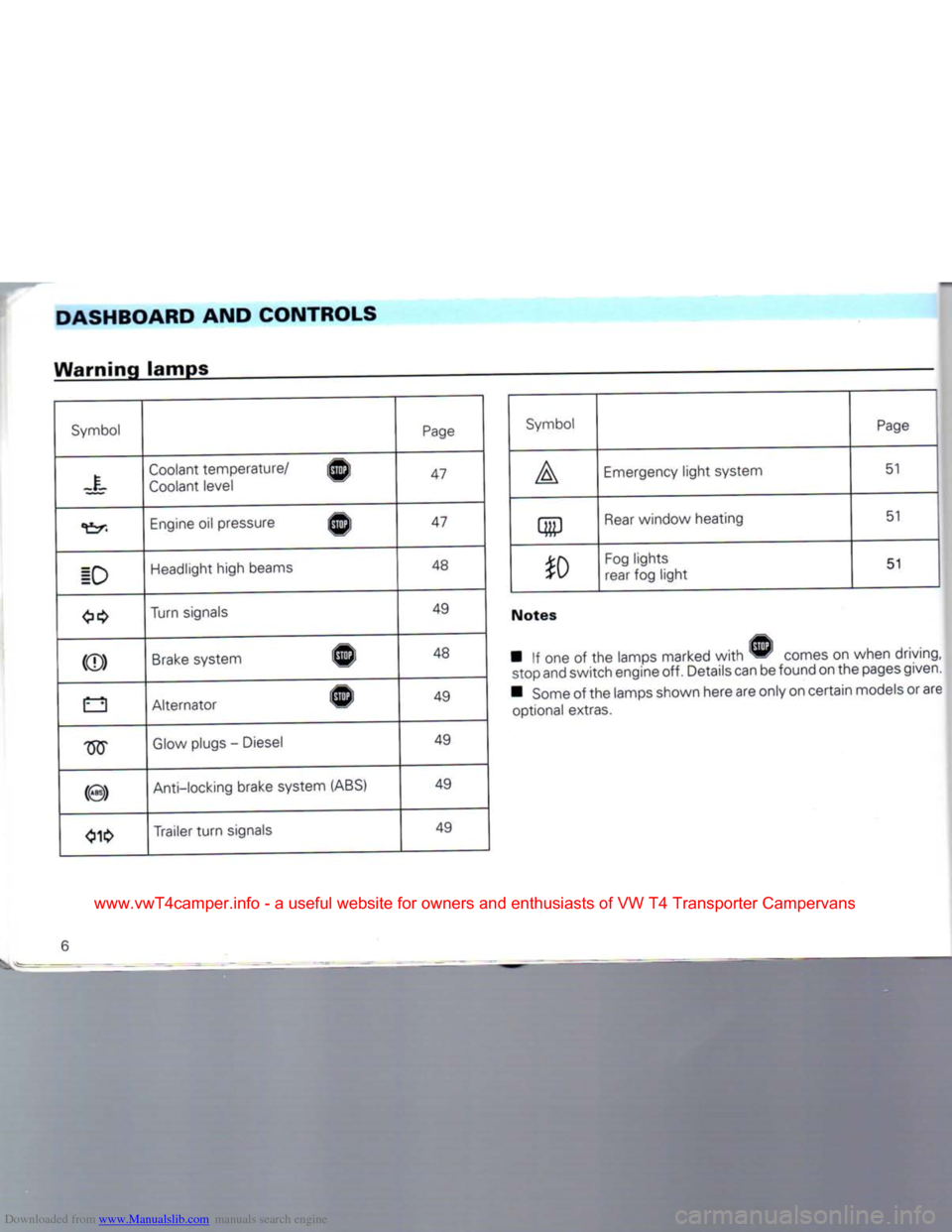
Downloaded from www.Manualslib.com manuals search engine
DASHBOARD
AND
CONTROLS
Warning lamps
Symbol Page Symbol
Page
Coolant temperature/
Coolant level
47
A Emergency light system
51
Engine oil pressure f^i
47
m Rear
window
heating
51
ID
Headlight
high
beams
48
to Fog lights
rear fog light 51
Turn
signals
49
Notes
((D)
Brake
system l^i
48
•
If one of the lamps marked
with
comes on when driving
stop and switch engine off. Details can be found on the pages
given
B Some of the lamps shown here are
only
on certain models or are optional extras.
£3
Alternator
49 •
If one of the lamps marked
with
comes on when driving
stop and switch engine off. Details can be found on the pages
given
B Some of the lamps shown here are
only
on certain models or are optional extras.
m Glow plugs - Diesel
49
(©)
Anti-locking brake system (ABS)
49
Trailer turn signals
49
6
www.vwT4camper.info - a useful website for owners and enthusiasts of VW T4 Transporter Campervans
Page 31 of 164
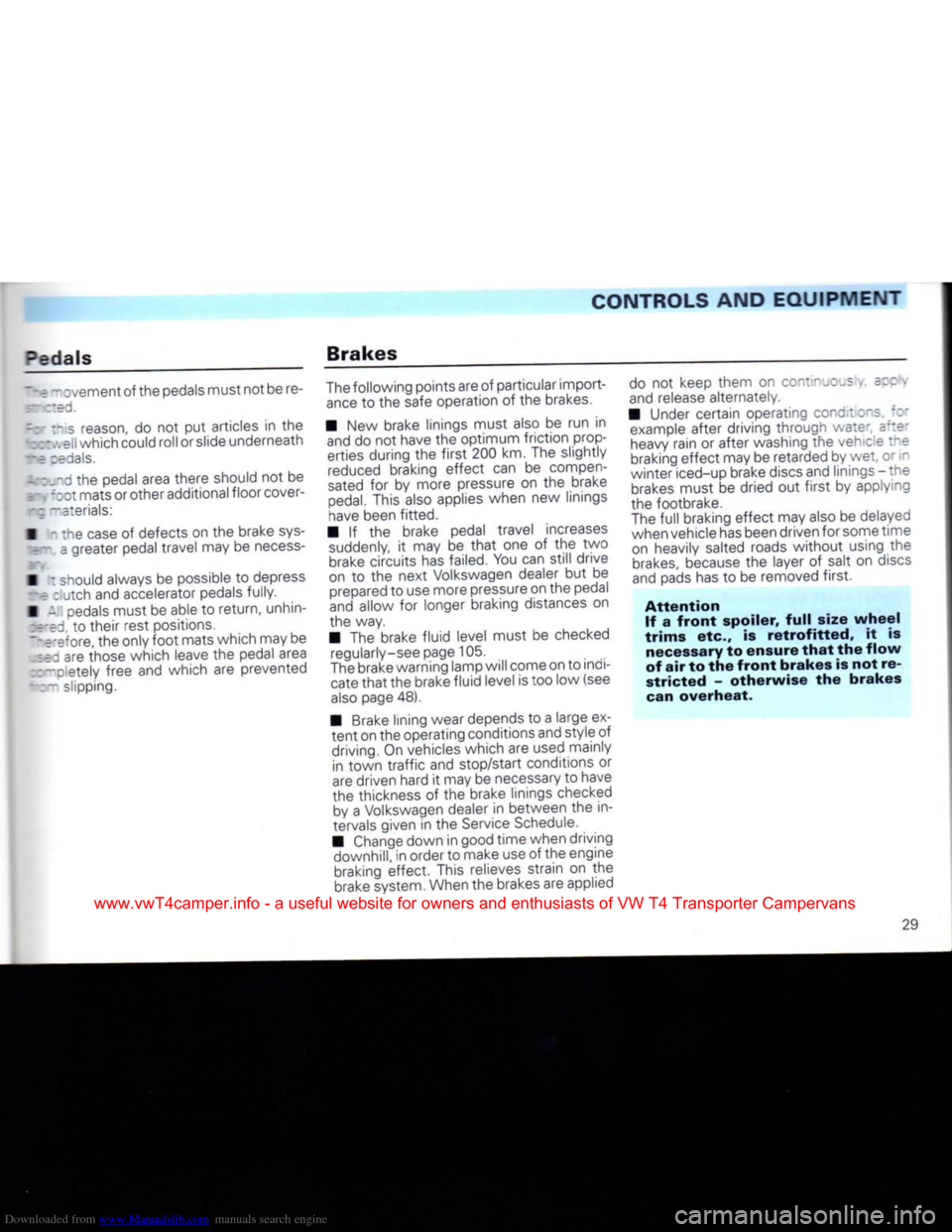
Downloaded from www.Manualslib.com manuals search engine
CONTROLS AND EQUIPMENT
3edals
• e ~ cvement of the pedals must not be re-
:: :~is reason, do not put articles in the
—•".•.ell which could roll or slide underneath
—-E-
zedals.
•Vr^-d the pedal area there should not be •r. -;otmatsorotheradditionalfloorcover- •: -aterials:
• In the
case
of defects on the brake sys-
r~
3 greater pedal travel may be
necess-
• : should always be possible to depress
~3
: _tch and accelerator pedals fully.
• - pedals must be able to return, unhin-
z-z'^z.
to their rest positions,
""•e'efore, the only
foot
mats which may be
are those which leave the pedal area
::—oletely free and which are prevented . " slipping. Brakes
The following points are of particular import
ance
to the safe operation of the brakes.
• New brake linings must also be run in and do not have the optimum
friction
prop
erties during the
first
200 km. The slightly reduced braking effect can be compen
sated for by more pressure on the brake
pedal.
This also applies when new linings have been fitted.
• If the brake pedal travel increases suddenly, it may be
that
one of the two
brake circuits has failed. You can still drive
on to the next Volkswagen dealer but be prepared to use more pressure on the pedal
and allow for longer braking distances on
the way.
• The brake
fluid
level must be checked regularly-see page 105.
The brake warning lamp
will
come on to indi cate
that
the brake
fluid
level is too low (see
also
page 48).
• Brake lining wear depends to a large ex
tent
on the operating conditions and style of driving. On vehicles which are used mainly in
town
traffic
and stop/start conditions or
are driven hard it may be necessary to have
the thickness of the brake linings checked by a Volkswagen dealer in between the in
tervals given in the Service Schedule.
• Change down in good time when driving downhill, in orderto make use of the engine braking effect. This relieves strain on the
brake system. When the brakes are applied do not keep them on con::rjc_s , =" .
and release alternately.
• Under certain operating conditions, *c example after driving through water, a^e' heavy rain or after washing the vehicle the
braking effect may be retarded by wet, or in
winter iced-up brake discs and linings - the brakes must be dried out
first
by applying
the footbrake.
The
full
braking effect may also be delayed when vehicle has been driven for some time
on heavily salted roads
without
using the
brakes,
because the layer of salt on discs
and pads has to be removed
first.
Attention
If a
front
spoiler,
full
size
wheel
trims
etc., is
retrofitted,
it is necessary to
ensure
that
the
flow
of air to the
front
brakes
is not re
stricted
-
otherwise
the
brakes
can
overheat.
www.vwT4camper.info - a useful website for owners and enthusiasts of VW T4 Transporter Campervans
Page 39 of 164
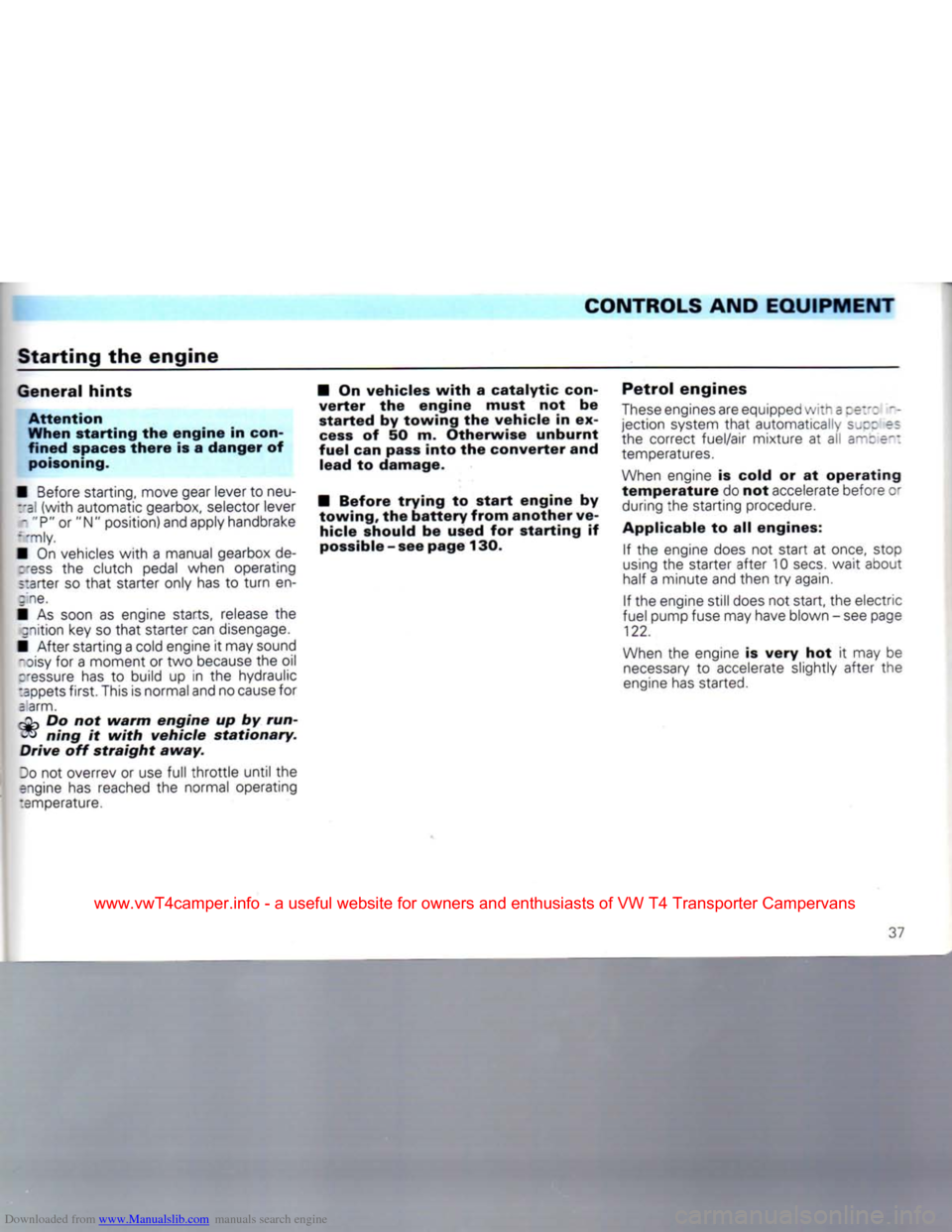
Downloaded from www.Manualslib.com manuals search engine
CONTROLS AND EQUIPMENT
Starting
the
engine
General
hints
Attention
When
starting
the
engine
in con
fined
spaces
there
is a
danger
of poisoning.
• Before starting, move gear lever to neu- ml
(with
automatic gearbox, selector lever -
"P"
or "N" position) and apply handbrake
I 'mly.
• On vehicles
with
a manual gearbox de-
:"9ss
the clutch pedal when operating
=:arter
so
that
starter only has to
turn
en
gine.
• As soon as engine starts, release the gnition key so
that
starter can disengage.
• After starting a cold engine it may sound
_oisy
for a moment or two because the oil pressure has to build up in the hydraulic
tappets
first.
This is normal and no cause for
a
arm. Do not
warm
engine
up by run-
W>
ning
it
with
vehicle
stationary.
Drive
off
straight
away.
Do
not overrev or use
full
throttle
until the
engine has reached the normal operating
Temperature. • On vehicles
with
a
catalytic
con
verter
the
engine
must
not be
started
by
towing
the
vehicle
in ex
cess
of 50 m.
Otherwise
unburnt
fuel
can pass
into
the
converter
and
lead
to
damage.
•
Before
trying
to
start
engine
by
towing,
the
battery
from
another
ve
hicle
should be used for
starting
if
possible - see
page
130.
Petrol
engines
These
engines are equipped
with
a cer: ~-
jection system
that
automatically s^c; es the correct fuel/air mixture at ail anc e~:
temperatures.
When
engine is cold or at
operating
temperature
do not accelerate before or
during the starting procedure.
Applicable to all engines:
If the engine does not start at once, stop
using
the starter after 10
sees,
wait about
half a minute and then try again. If the engine still does not start, the electric
fuel pump fuse may have blown - see page
122.
When
the engine is
very
hot it may be
necessary
to accelerate slightly after the
engine has started.
37
www.vwT4camper.info - a useful website for owners and enthusiasts of VW T4 Transporter Campervans
Page 49 of 164
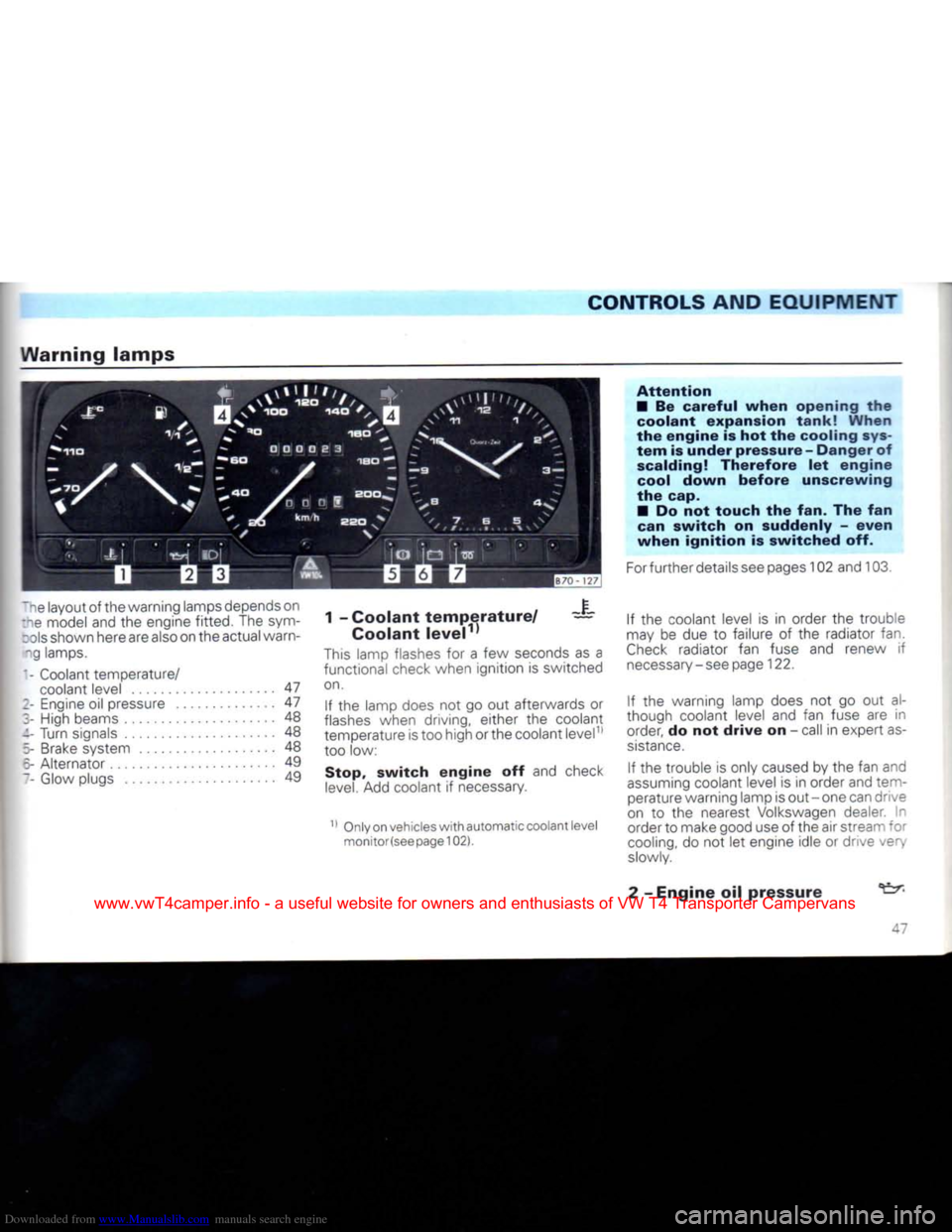
Downloaded from www.Manualslib.com manuals search engine
CONTROLS
AND
EQUIPMENT
Warning
lamps
~ne layout of the warning lamps depends on
:ne model and the engine fitted. The sym-
: ols shown here are also on the actual warn-ng lamps.
|- Coolant temperature/ coolant level 47
1- Engine oil pressure 47
I- High beams 48
-- Turn signals 48
5-
Brake system 48
V Alternator 49
" Glow plugs 49 Coolant
temperature/
Coolant level1'
This
lamp flashes for a few seconds as a
functional check when ignition is switched
on.
If the lamp does not go out afterwards or
flashes
when driving, either the coolant
temperature is too high orthe coolant level1'
too low:
Stop,
switch
engine
off and check
level.
Add coolant if necessary.
11 Only on vehicles
with
automatic coolant level monitor(see page 102).
Attention
• Be
careful
when
opening the
coolant
expansion
tank!
When
the
engine
is hot the cooling
sys
tem is
under
pressure -
Danger
of scalding!
Therefore
let
engine
cool
down
before
unscrewing
the cap.
• Do not
touch
the fan. The fan can
switch
on suddenly -
even
when
ignition
is
switched
off.
For
further details see pages 102 and 103.
If the coolant level is in order the trouble
may be due to failure of the radiator fan.
Check
radiator fan fuse and renew if
necessary-seepage
122.
If the warning lamp does not go out al
though coolant level and fan fuse are in order, do not
drive
on - call in expert as
sistance.
If the trouble is only caused by the fan and
assuming
coolant level is in order and tem perature warning lamp is out - one can drive
on to the nearest Volkswagen dealer. In
order to make good use of the air stream for
cooling,
do not let engine idle or drive very
slowly.
2 - Engine oil pressure -7
www.vwT4camper.info - a useful website for owners and enthusiasts of VW T4 Transporter Campervans
Page 50 of 164

Downloaded from www.Manualslib.com manuals search engine
CONTROLS
AND EQUIPMENT
The
warning lamp flashes when ignition is
switched
on. the lamp must go out when
engine
has started.
If the warning lamp does not go out or
flashes
when driving - a buzzer also sounds
at engine speeds above 2000 rpm - stop,
switch
engine
off, check oil level and if
necessary,
add oil - see page 97.
If the lamp comes on although the oil level
is
in order, do not
drive
on. Do not even
run the engine at idling speed-call in expert
assistance.
Note
The oil pressure
warning
lamp
is not an oil
level
indicator.
The oil
level
should
therefore
be checked at reg
ular
intervals,
preferably
every
time
the
fuel
tank
is filled.
3 -
High
beams 10 4 - Turn signals
The
warning lampflashes when
turn
signals
are
switched on. If a
turn
signal fails, the
warning lamp flashes twice as fast. (Not
when towing a trailer).
Further
details are given on pages 49
and
52. 5 -
Brake
system «^
The
warning lamp comes on when
• the handbrake is on
• the brake fluid level is too low
The
ignition must be switched on.
Attention
If the
lamp
does not go out
when
handbrake
is released or comes
on
when
driving, the
fluid
level
in
the reservoir is too low. If an in crease in
pedal
free
travel
is no
ticed
at the same
time,
one of the
brake
circuits may
have
failed.
You can
drive
on
carefully
to the
nearest
Volkswagen
dealer
but
allow
for
higher
pedal
pressures and longer
braking
distances on
the way.
The
warning lamp comes on when high
beams
are on or when the headlight flasher
is
used.
48
www.vwT4camper.info - a useful website for owners and enthusiasts of VW T4 Transporter Campervans
Page 82 of 164
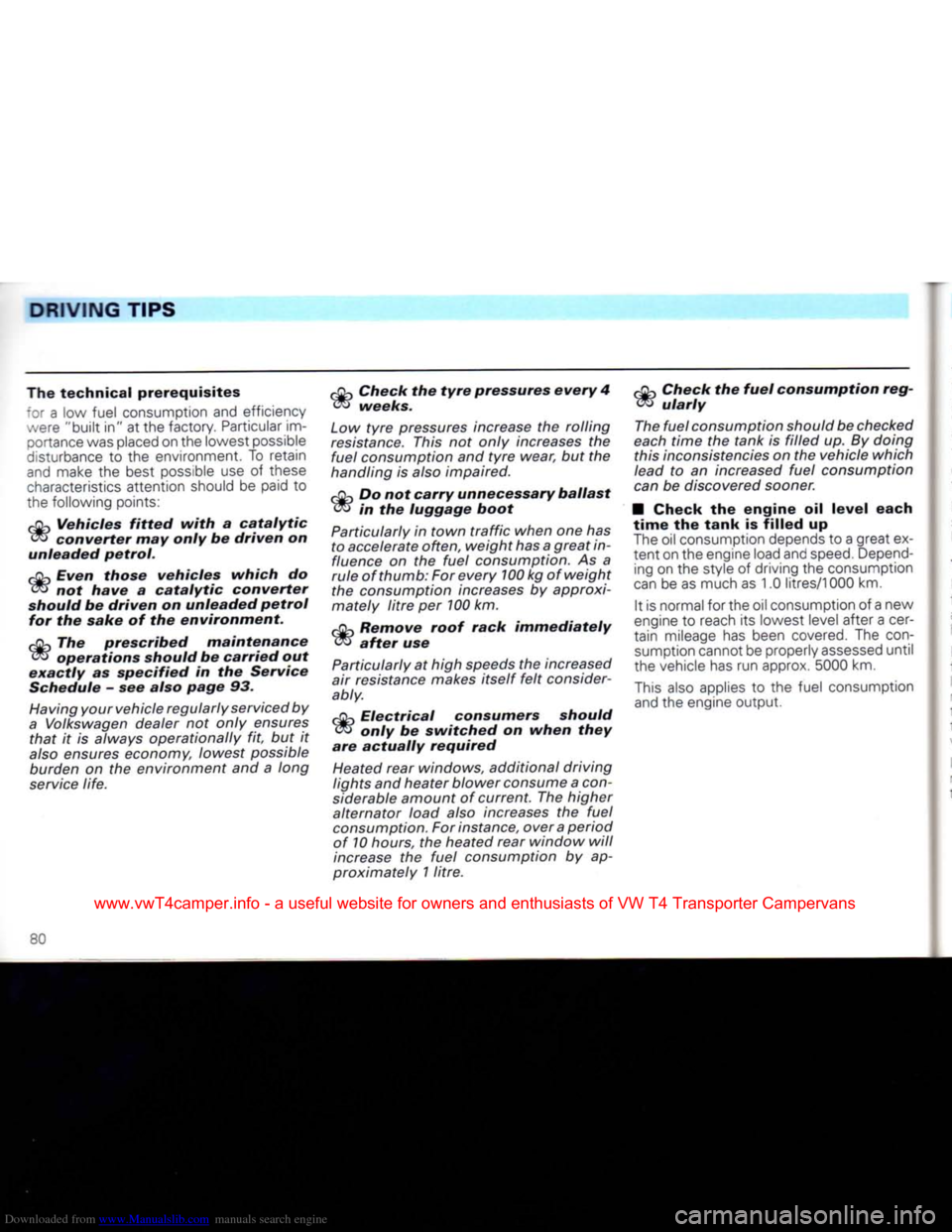
Downloaded from www.Manualslib.com manuals search engine
DRIVING
TIPS
The technical
prerequisites
"or
a low fuel consumption and efficiency were "built in" at the factory. Particular im
portance was placed on the lowest possible
disturbance
to the environment. To retain
and
make the best possible use of these
characteristics
attention should be paid to
the following points:
Vehicles
fitted
with
a
catalytic
converter
may
only
be
driven
on
unleaded
petrol.
Even
those
vehicles
which
do
not
have
a
catalytic
converter
should
be
driven
on
unleaded
petrol
for the
sake
of the
environment.
The
prescribed
maintenance
operations
should
be
carried
out
exactly
as
specified
in the
Service
Schedule - see
also
page
93.
Having your vehicle regularly serviced by
a Volkswagen dealer not
only
ensures
that
it is always operationally fit, but it
also ensures economy, lowest possible burden on the environment and a long
service
life.
Check the
tyre
pressures
every
4
weeks.
Low
tyre
pressures increase the rolling
resistance.
This not
only
increases the
fuel
consumption and
tyre
wear,
but the
handling is also impaired.
Do not
carry
unnecessary
ballast
in the
luggage
boot
Particularly in
town
traffic
when one has to accelerate
often,
weight
has a
great
in
fluence on the
fuel
consumption. As a
rule
of
thumb:
For every 100 kg of
weight
the consumption increases by approxi
mately
litre
per 100 km.
Remove
roof
rack
immediately
after
use
Particularly at
high
speeds the increased
air resistance makes
itself
felt
consider
ably.
gCK
Electrical
consumers
should
only
be
switched
on
when
they
are
actually
required
Heated rear windows, additional driving
lights
and heater blower consume a con
siderable amount of
current.
The higher
alternator
load
also increases the
fuel
consumption. For instance, over a period of 10 hours, the heated rear window
will
increase
the
fuel
consumption by ap
proximately 1
litre.
Check the
fuel
consumption
reg
ularly
The
fuel
consumption should be checked
each
time
the
tank
is
filled
up. By doing
this
inconsistencies on the vehicle which
lead to an increased
fuel
consumption
can be discovered sooner.
• Check the
engine
oil
level
each
time
the
tank
is
filled
up
The
oil consumption depends to a great ex
tent
on the engine load and
speed.
Depend
ing on the style of driving the consumption
can
be as much as 1.0 litres/1000 km.
It is normal for the oil consumption of a new
engine
to reach its lowest level after a cer
tain mileage has been covered. The
con
sumption cannot be properly
assessed
until
the vehicle has run approx. 5000 km.
This
also
applies to the fuel consumption
and
the engine output.
www.vwT4camper.info - a useful website for owners and enthusiasts of VW T4 Transporter Campervans
Page 97 of 164
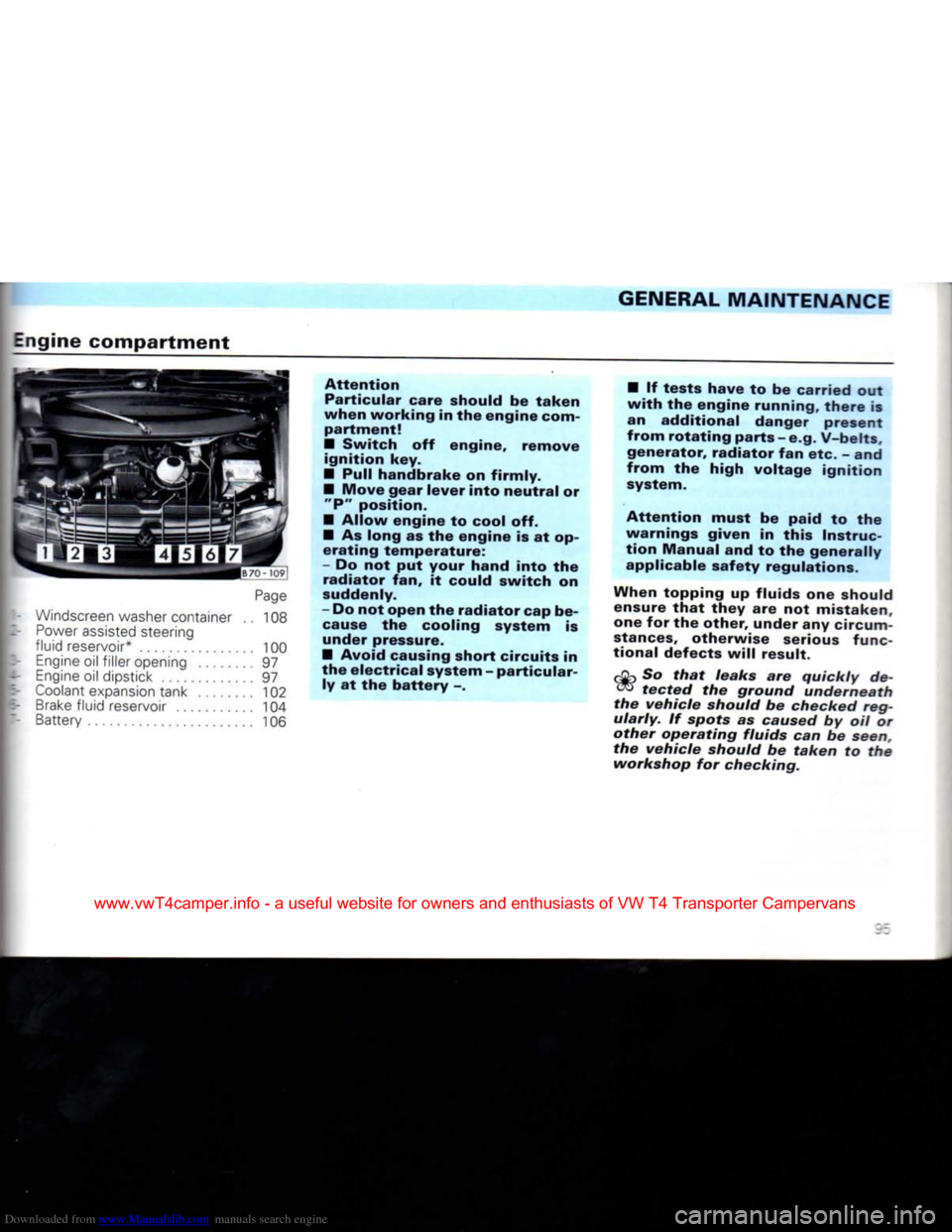
Downloaded from www.Manualslib.com manuals search engine
GENERAL
MAINTENANCE
Engine
compartment
Page
Windscreen
washer
container
.. 108
Power
assisted
steering
fluid
reservoir*
100
Engine
oil filler
opening
97
Engine
oil
dipstick
97
Coolant
expansion
tank 102
Brake
fluid
reservoir
104
Battery
106 Attention
Particular care should be
taken
when working in the engine
com
partment!
•
Switch off engine, remove ignition key.
•
Pull handbrake on firmly.
•
Move gear lever into neutral or
"P"
position.
•
Allow engine to cool off.
•
As long as the engine is at op
erating temperature:
-
Do not put your hand into the radiator fan, it could switch on
suddenly.
-
Do not open the radiator cap be
cause
the cooling system is
under
pressure.
•
Avoid causing short circuits in
the electrical system - particular ly at the
battery
-.
•
If tests have to be
carried
out
with
the engine running,
there
is
an additional danger
present
from rotating parts - e.g.
V-belts,
generator, radiator fan etc. - and
from the high voltage ignition
system.
Attention must be paid to the warnings given in this Instruc
tion Manual and to the generally
applicable
safety regulations.
When topping up fluids one
should
ensure
that
they are not mistaken,
one
for the other, under any
circum
stances,
otherwise serious
func
tional defects
will
result.
So
that
leaks
are quickly de
tected
the ground underneath
the vehicle should be checked
reg
ularly.
If spots as caused by oil or
other
operating fluids can be seen, the vehicle should be
taken
to the
workshop for checking.
www.vwT4camper.info - a useful website for owners and enthusiasts of VW T4 Transporter Campervans
Page 104 of 164
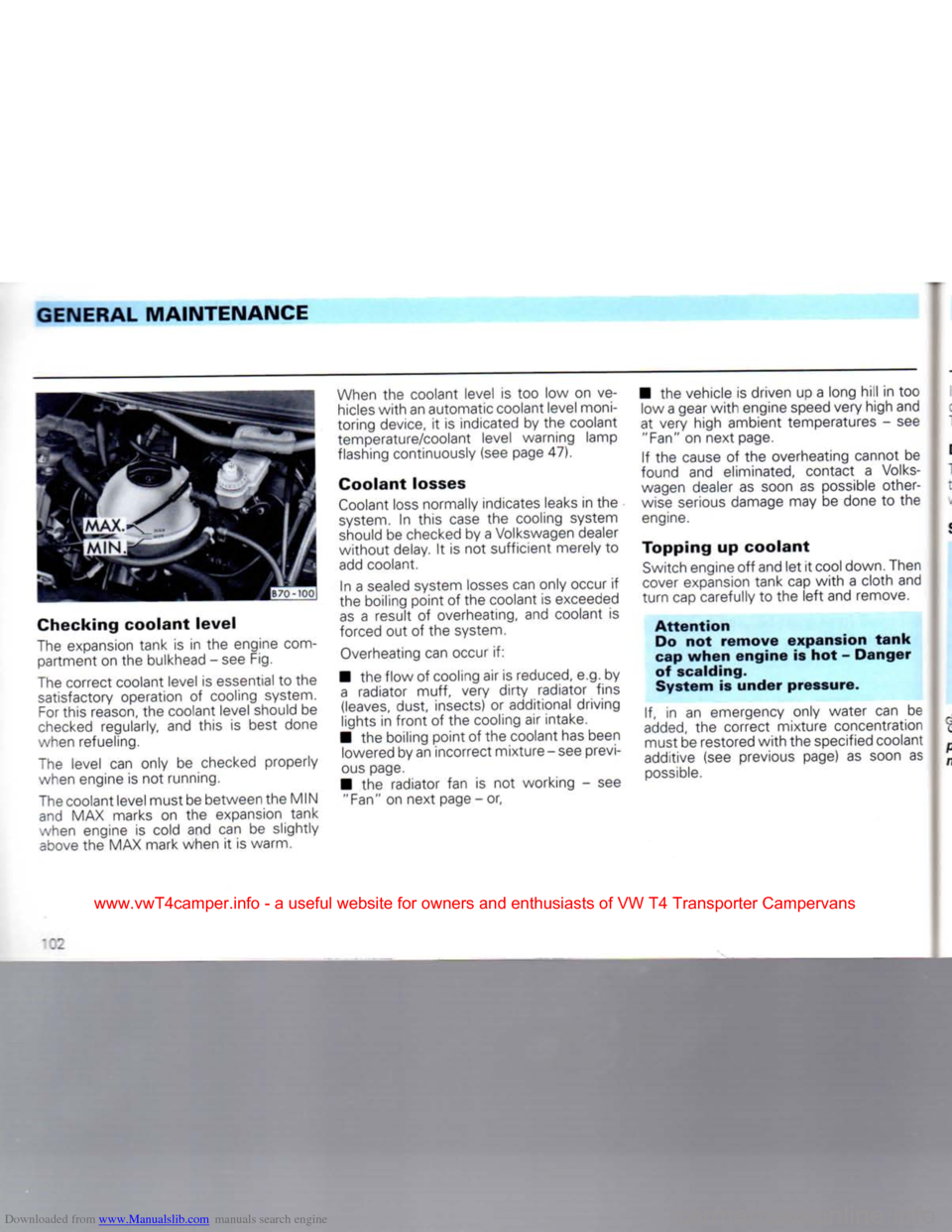
Downloaded from www.Manualslib.com manuals search engine
GENERAL
MAINTENANCE
Checking
coolant
level
The
expansion tank
is in the
engine
com
partment on the bulkhead
-
see Fig.
The
correct coolant level
is
essential
to
the satisfactory operation
of
cooling system.
For
this reason, the coolant level should
be
checked
regularly,
and
this
is
best done
when refueling.
The
level
can
only
be
checked properly
when engine
is
not running.
The
coolant level must be between the MIN
and
MAX marks
on the
expansion tank
when engine
is
cold
and can be
slightly
above
the MAX mark when
it
is warm.
When
the
coolant level
is too low on ve
hicles
with
an automatic coolant level moni
toring device,
it is
indicated by the coolant
temperature/coolant level warning lamp
flashing continuously (see page 47).
Coolant
losses
Coolant
loss normally indicates leaks in the
system.
In
this
case
the
cooling system
should
be checked by a Volkswagen dealer
without
delay.
It is
not sufficient merely
to
add
coolant.
In
a
sealed system
losses
can only occur
if
the boiling point
of
the coolant is exceeded
as
a
result
of
overheating, and coolant
is
forced out
of
the system.
Overheating can occur
if:
• the flow
of
cooling air is reduced, e.g.
by
a
radiator
muff,
very
dirty
radiator fins
(leaves,
dust, insects)
or
additional driving
lights
in
front
of
the cooling air intake.
• the boiling point
of
the coolant has been lowered by an incorrect mixture
-
see previ
ous
page.
•
the
radiator
fan is not
working
- see
"Fan"
on next page
-
or, • the vehicle
is
driven up
a
long hill
in too
low a gear
with
engine speed very high and
at very high ambient temperatures
-
see
"Fan"
on
next page.
If
the
cause
of the
overheating cannot
be
found
and
eliminated, contact
a
Volks
wagen dealer
as
soon
as
possible other
wise
serious damage may
be
done
to the
engine.
Topping
up
coolant
Switch
engine
off
and let
it
cool down. Then
cover
expansion tank cap
with
a
cloth and
turn
cap carefully
to
the
left
and remove.
Attention
Do
not
remove
expansion
tank
cap
when
engine
is
hot
-
Danger
of scalding.
System
is
under
pressure.
If, in an
emergency only water
can be
added,
the
correct mixture concentration must be restored
with
the specified coolant
additive (see previous page)
as
soon
as
possible.
•02
www.vwT4camper.info - a useful website for owners and enthusiasts of VW T4 Transporter Campervans
Page 112 of 164
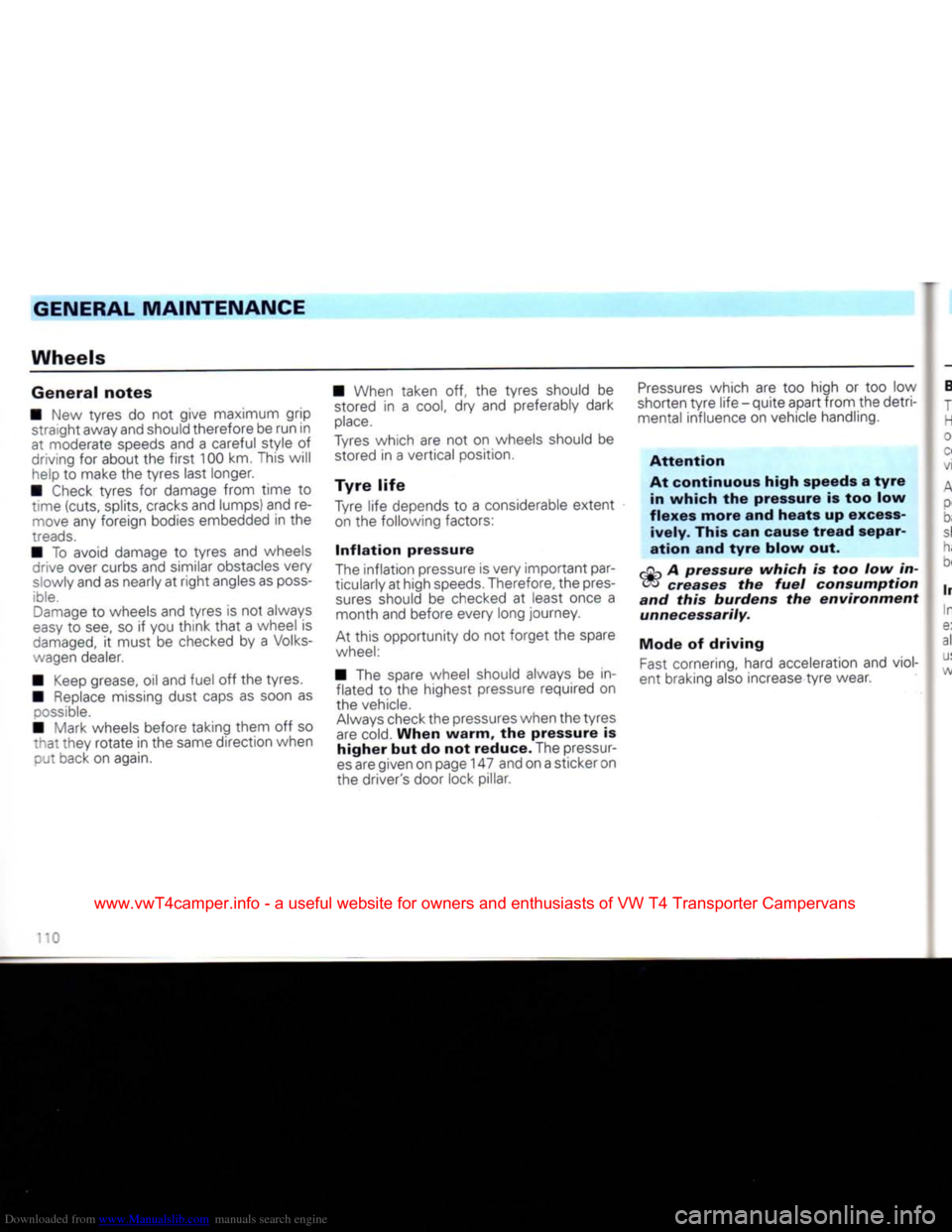
Downloaded from www.Manualslib.com manuals search engine
GENERAL
MAINTENANCE
Wheels
General
notes
• New tyres do not give maximum grip straight away and should therefore be run in
at moderate speeds and a careful style of
driving for about the
first
100 km. This will help to make the tyres last longer.
• Check tyres for damage from time to time (cuts, splits, cracks and lumps) and remove any foreign bodies embedded in the
treads.
• To avoid damage to tyres and wheels crive over curbs and similar obstacles very
slowly and as nearly at
right
angles as
poss
ible.
Damage
to wheels and tyres is not always
easy
to see, so if you
think
that
a wheel is
damaged,
it must be checked by a Volks
wagen dealer.
• Keep grease, oil and fuel off the tyres.
• Replace missing dust caps as soon as
possible.
• Mark wheels before taking them off so
that
they rotate in the same direction when put back on again. • When taken off, the tyres should be
stored in a
cool,
dry and preferably dark
place.
Tyres
which are not on wheels should be stored in a vertical position.
Tyre
life
Tyre life depends to a considerable extent on the following factors:
Inflation
pressure
The inflation pressure is very important par
ticularly at high
speeds.
Therefore, the pres
sures
should be checked at least once a month and before every long journey.
At this opportunity do not forget the spare
wheel:
• The spare wheel should always be in flated to the highest pressure required on
the vehicle.
Always
check the pressures when the tyres are cold.
When
warm,
the pressure is
higher
but do not
reduce.
The pressur
es
are given on page 147 and on a sticker on
the driver's door lock pillar.
Pressures
which are too high or too low
shorten
tyre
life - quite apart from the detri mental influence on vehicle handling.
Attention
At
continuous
high
speeds a
tyre
in
which
the pressure is too low
flexes
more
and
heats
up excess
ively.
This can cause
tread
separ
ation
and
tyre
blow
out.
pCU
A
pressure
which
is too low in- oo
creases
the
fuel
consumption
and
this
burdens
the
environment
unnecessarily.
Mode
of
driving
Fast
cornering, hard acceleration and viol
ent braking also increase
tyre
wear.
'0
www.vwT4camper.info - a useful website for owners and enthusiasts of VW T4 Transporter Campervans